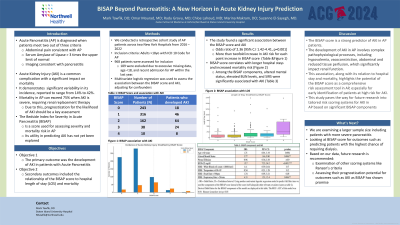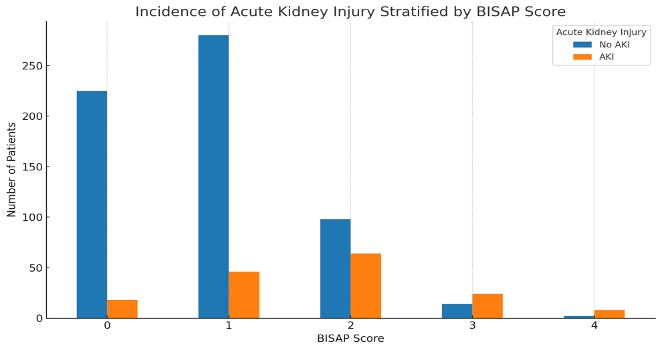Tuesday Poster Session
Category: Biliary/Pancreas
P3471 - BISAP Beyond Pancreatitis: A New Horizon in Acute Kidney Injury Prediction
Tuesday, October 29, 2024
10:30 AM - 4:00 PM ET
Location: Exhibit Hall E

Has Audio
.jpg)
Mark Tawfik, DO
Staten Island University Hospital, Northwell Health
Staten Island, NY
Presenting Author(s)
Mark Tawfik, DO1, Omar Mourad, MD1, Radu Grovu, MD1, Chloe Lahoud, MD1, Marina Makram, DO1, Suzanne El-Sayegh, MD2
1Staten Island University Hospital, Northwell Health, Staten Island, NY; 2Staten Island University Hospital, Staten Island, NY
Introduction: Acute kidney injury (AKI) is a common complication in acute pancreatitis (AP), with a significant impact on mortality. It demonstrates a significant variability in its incidence, reported to range from 14% to 42%. When renal replacement therapy is required in patients with AKI, mortality rates can exceed 75%. The Bedside Index for Severity in Acute Pancreatitis (BISAP) score is well-established for assessing mortality risk in AP, but its utility in predicting AKI is less explored.
Methods: We conducted a retrospective cohort study of 779 AP patients across two hospitals in New York, USA, from 2016 to 2022. Data on patient demographics, laboratory values, and vital signs were collected. BISAP scores were calculated. The primary outcome was AKI, defined by the KDIGO criteria. Multivariate logistic regression was done to assess the association between the BISAP score and AKI, adjusting for confounders. Secondary outcomes includes the association of the BISAP score to hospital length of stay and mortality.
Results: There was a significant association between the BISAP score and AKI, with an odds ratio of 2.36 [95% C.I 1.42-4.41, p =0.001], indicating a more than twofold increase in AKI risk for each point increase in BISAP score. The BISAP score was also significantly correlated with longer hospital stays and increased mortality risk.
Discussion: The development of AKI in AP involves complex pathophysiological processes, including hypovolemia, vasoconstriction, abdominal and reduced tissue perfusion, which significantly impact renal function. Our study found that the BISAP score is a strong predictor of AKI in AP patients. This association and relation to hospital stay and mortality highlights the potential of the BISAP score as a comprehensive risk assessment tool in AP, especially for early identification of patients at high risk for AKI. This study paves the way for future research into risk scoring systems for AKI in AP based on significant BISAP components.

Note: The table for this abstract can be viewed in the ePoster Gallery section of the ACG 2024 ePoster Site or in The American Journal of Gastroenterology's abstract supplement issue, both of which will be available starting October 27, 2024.
Disclosures:
Mark Tawfik, DO1, Omar Mourad, MD1, Radu Grovu, MD1, Chloe Lahoud, MD1, Marina Makram, DO1, Suzanne El-Sayegh, MD2. P3471 - BISAP Beyond Pancreatitis: A New Horizon in Acute Kidney Injury Prediction, ACG 2024 Annual Scientific Meeting Abstracts. Philadelphia, PA: American College of Gastroenterology.
1Staten Island University Hospital, Northwell Health, Staten Island, NY; 2Staten Island University Hospital, Staten Island, NY
Introduction: Acute kidney injury (AKI) is a common complication in acute pancreatitis (AP), with a significant impact on mortality. It demonstrates a significant variability in its incidence, reported to range from 14% to 42%. When renal replacement therapy is required in patients with AKI, mortality rates can exceed 75%. The Bedside Index for Severity in Acute Pancreatitis (BISAP) score is well-established for assessing mortality risk in AP, but its utility in predicting AKI is less explored.
Methods: We conducted a retrospective cohort study of 779 AP patients across two hospitals in New York, USA, from 2016 to 2022. Data on patient demographics, laboratory values, and vital signs were collected. BISAP scores were calculated. The primary outcome was AKI, defined by the KDIGO criteria. Multivariate logistic regression was done to assess the association between the BISAP score and AKI, adjusting for confounders. Secondary outcomes includes the association of the BISAP score to hospital length of stay and mortality.
Results: There was a significant association between the BISAP score and AKI, with an odds ratio of 2.36 [95% C.I 1.42-4.41, p =0.001], indicating a more than twofold increase in AKI risk for each point increase in BISAP score. The BISAP score was also significantly correlated with longer hospital stays and increased mortality risk.
Discussion: The development of AKI in AP involves complex pathophysiological processes, including hypovolemia, vasoconstriction, abdominal and reduced tissue perfusion, which significantly impact renal function. Our study found that the BISAP score is a strong predictor of AKI in AP patients. This association and relation to hospital stay and mortality highlights the potential of the BISAP score as a comprehensive risk assessment tool in AP, especially for early identification of patients at high risk for AKI. This study paves the way for future research into risk scoring systems for AKI in AP based on significant BISAP components.

Figure: Figure 1: The bar chart visualizes the incidence of Acute Kidney Injury (AKI) stratified by BISAP scores. Each BISAP score is represented by two bars: one indicating the number of cases with AKI and the other showing the number of cases without AKI. The visual representation allows for an easy comparison of AKI incidence across different BISAP scores
Note: The table for this abstract can be viewed in the ePoster Gallery section of the ACG 2024 ePoster Site or in The American Journal of Gastroenterology's abstract supplement issue, both of which will be available starting October 27, 2024.
Disclosures:
Mark Tawfik indicated no relevant financial relationships.
Omar Mourad indicated no relevant financial relationships.
Radu Grovu indicated no relevant financial relationships.
Chloe Lahoud indicated no relevant financial relationships.
Marina Makram indicated no relevant financial relationships.
Suzanne El-Sayegh indicated no relevant financial relationships.
Mark Tawfik, DO1, Omar Mourad, MD1, Radu Grovu, MD1, Chloe Lahoud, MD1, Marina Makram, DO1, Suzanne El-Sayegh, MD2. P3471 - BISAP Beyond Pancreatitis: A New Horizon in Acute Kidney Injury Prediction, ACG 2024 Annual Scientific Meeting Abstracts. Philadelphia, PA: American College of Gastroenterology.
